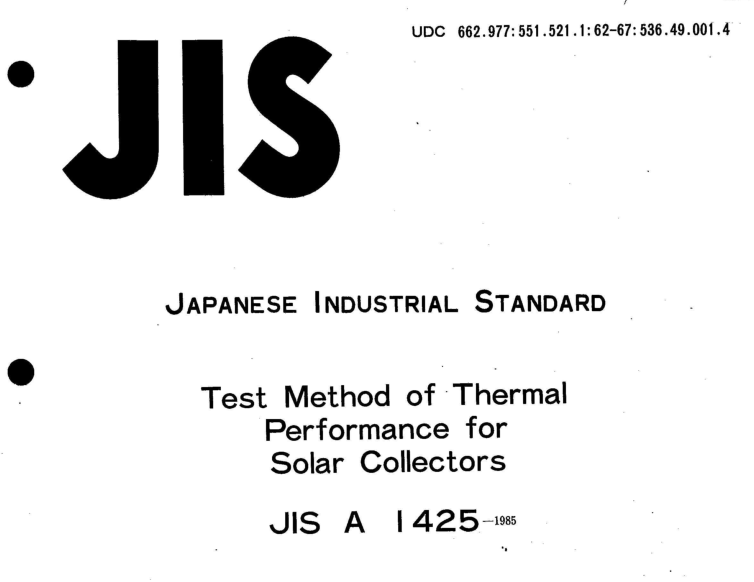JIS A1425:1985 pdfダウンロード

JIS A1425:1985 pdfダウンロード。Test Method of Thermal Performance for Solar Collectors
Scope
This Japanese Industrial Standard specifies the testing method forthethermal performance of non-tracking solar heat collectors of the flat platetype, vacuum glass tube type, and other types which collect solar heat inthe form of sensible heat by compulsorily circulating a liquid as the heatcollecting medium, hereinafter referred to as the “solar collectors”.
This standard also covers solar collectors having reflectors, thosehaving light collectors, and those having an operating medium for con-ducting heat from the absorber to the heat collecting medium; such as heatpipe type solar collectors, but does not apply to solar collectors having nottransmitter or those having a large heat capacity or a heat storingfunction.
The units and numerical values given in ( ] in this standardRemark:are in accordance with the International System of Units (SI)and are appended for reference.
Definitions
The main terms used in this standard mean as follows:
absorberThe part which absorbs incident solar radiation energywhich has penetrated the transmitter and transforms it into thermalenergy and transfers it to the heat collecting medium.
The medium which takes out thermal energyheat collecting mediumfrom the solar collector and transfers it to the heat utilizing system
operating mediumIn a heat pipe type solar collector and the like,the medlum which transfers thermal energy from the absorber to theheat collecting medium.
transmitterThe part which is used on the surface of the solarcollector to transmit solar light and reduce the convection from theabsorber and the loss in radiant heat.
5reflectorThe part which reflects insolation energy to increase thequantity of incidence on the absorber.
light collector The part consisting of a lens or a reflecting body inthe form of a curved surface or bent plate, which optically collectsinsolation energy to the absorber.
heat collecting planeThe plane that is parallel to the plane onwhich the projected area of the absorber by parallel light is largestand that is positioned directly before the transmitter. However,insolar collectors having a light collector, it means the plane on whichthe aperture area of the light collector is largest.
The product of the largest width andtotal area of solar collectorargest length of the solar collector excluding projected parts suchas fittings for installation of the solar collector and pipe connectingparts.
heat collecting plane insulation intensity The insolation energyrecelved by the unit area of heat collecting plane per unit time.
collected heat quantityThe thermal energy obtained into the heatcollecting medium by the solar collector, which is the product of theflow rate of circulating heat capacity in the solar collector (mass flowrate x average specific heat) and the temperature difference betweenthe outlet and inlet of the solar collector.
instantancous heat collecting efficiencyThe value obtained bydividing the collected heat quantity of the solar collector in a giventime (4T) by the integrated value of the insolation energy falling onthe total area of the solar collector in the time 4T.
reception without heat collecting mediumThe reception of insolationenergy by the solar collector in the condition of containing no heatcollecting medium. However,in heat pipe type solar collectors,itmeans such reception in the condition of containing the operatingmedium .
angle of incidenceThe angle formed by the normal line to the heatcollecting plane and the direction pointing to the sun or the illumi-nant of the solar simulator.
solar simulatorA device which emits light simulating the solarspectrum for the purpose of conducting indoor tests for the heatcollecting performance and the lke of the solar collector.
The radiant energy received by the irradiated surfaceirradianceper unit area per unit time.
heat collecting efficiency variableThe value obtained by dividingthe difference between the average temperature of the heat collectingmedium in the solar collector and the atmospheric or ambienttemperature by the insolation intensity or irradiance on the heat
collecting plane.
- Previous:JIS A1323:1984 pdfダウンロード
- Next:JIS A1426:1985 pdfダウンロード